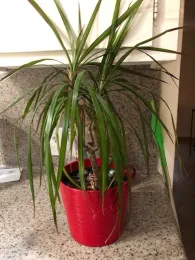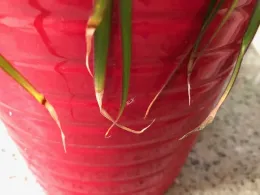Leach Your Houseplants to Avoid Salt Problems

Soluble salts are naturally occurring minerals, such as sodium, chloride, boron, calcium, and magnesium, that are dissolved in water. Some of the water in Stanislaus County has relatively high levels of certain salts, but in general, all water has some salt. Fertilizer dissolved in water also turns into a soluble salt. After water evaporates from the potting soil, the salts stay behind. Eventually, an excessive amount of salt may be absorbed by the roots, move upward in the plant, and concentrate in the leaves, causing tip burn. As salts in the soil become more concentrated, plants find it harder and harder to take up water. If enough salt accumulates in the soil, the water absorbing root tips are killed, and the plant begins to wilt and drop leaves.
To combat this problem, be sure you water correctly. Water plants enough so that some water moves through the soil and out the pot's drain hole. Then empty the drip plate. Do not allow the pot to sit in water. If drained water is reabsorbed by the soil, the salts that were washed away are taken back into the soil. The process of removing soil salts is called “leaching.”
It's a good idea to leach your house plants every two or three months. To do this, water the soil thoroughly, as you usually would. Then, after about five minutes, water again, letting excess water flow out the bottom drain holes. The first watering dissolves the salts, and the second washes the salts out of the soil.

For more information, consult the UC IPM Pest Notes: Houseplant Problems.
Ed Perry is the emeritus Environmental Horticultural Advisor for University of California Cooperative Extension (UCCE) in Stanislaus County where he worked for over 30 years.
